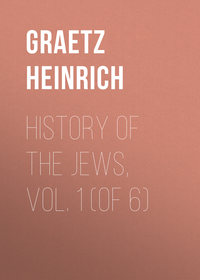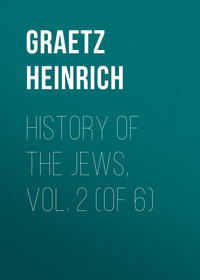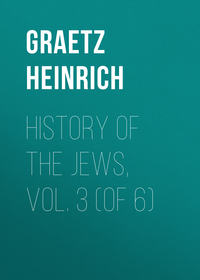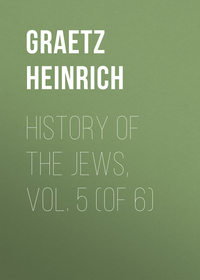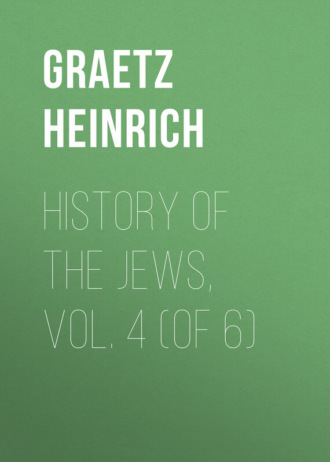 полная версия
полная версияHistory of the Jews, Vol. 4 (of 6)
Chasdaï Crescas, the first to distinguish between universal religion and specific forms, such as Judaism and Christianity, propounded, deviating from Maimuni's system, only eight peculiarly Jewish tenets. His just objection to Maimuni's thirteen articles of faith was that they were either too many or too few, inasmuch as they blended indiscriminately fundamental truths common to all religions, and teachings peculiar to Judaism.
Together with Profiat Duran and Chasdaï Crescas, Don Meïr Alguades, the Castilian chief rabbi, appeared, in the brief interval between two bloody persecutions in Spain, as a writer of philosophic works. He was not an independent inquirer; he merely translated the ethics of Aristotle (1405, in collaboration with Benveniste Ibn-Labi) into Hebrew, making the work accessible to Jews, who, in practical life, lived up to its principles better than the Greeks, who produced them, or the Christians, who, in the pride of faith and church doctrine, considered themselves above the necessity of conforming to the requirements of morality.
Throughout the reign of Don Henry III of Castile the life of the Jews was tolerable. The young but vigorous monarch severely punished Fernan Martinez, the prime mover in the massacres of 1391, as a warning against further excesses. He permitted the Jews to acquire land, renewed the law of his ancestor, Alfonso XI, and relieved his Jewish tax-farmers and finance administrators from restrictions. As soon as he died (the end of 1406) the affairs of the Jews again took an unfavorable turn, foreshadowing unhappy times. The heir to the crown, Juan II, was a child, barely two years old. The regency devolved on the queen-mother, Catalina (Catherine) of Lancaster, a capricious, arrogant and bigoted young woman, who imagined that she ruled, while she was herself ruled by her various favorites. The co-regent, Don Ferdinand, later king of Aragon, who was intelligent and kind, allowed himself to be guided by the clergy. By his side in the council of state sat the apostate rabbi, Solomon alias Paul de Santa Maria, another and more mischievous Elisha-Acher, in whose eyes Judaism was an abomination, and every Jew a stumbling-block. The deceased king, Don Henry III, had appointed him executor of his will and tutor to his heir; he consequently had an influential voice in the council of the regency. What a prospect for the Jews of Castile! It was not long before they were made to feel the hostile spirit of the court. First it exhibited itself in attempts to humiliate the more notable Jews who had intercourse with the court circle and the grandees of the kingdom, and occupied positions of distinction. The intention was to dismiss them from these positions with the reminder that they belonged to a despised caste.
An edict was issued (October 25th, 1408), in the name of the infant king, reviving the anti-Jewish statutes of the code of Alfonso the Wise. "Whereas the exercise of authority by Jews may conduce to the prejudice of the Christian faith," their occupation of posts in which they might possess such authority was forbidden for all future time. Every Jew permitting himself to be invested with official functions, either by a nobleman or a municipality, was to be fined twice the amount of the revenue of such post, and, if his fortune did not suffice to make up the required amount, it would be confiscated, and the delinquent become liable to a punishment of fifty lashes. A Christian appointing a Jew to a post of influence would also be punished with a fine. To insure the working of the edict, it was enacted that the informer and the court of law concerned in a case should secure each one-third of the confiscated estates. Officials were charged to make the edict known everywhere, and carefully to watch that its injunctions were carried out. It is impossible not to suspect the hand of Paul de Santa Maria in this decree. No one knew better than he the strong and the weak points in the character of the Spanish Jews, and he doubtless calculated that Jewish notables, in danger of losing their official employment and high social position, would go over to Christianity, while the faithful, excluded from intercourse with Christian society and from participation in the public life of the country, would suffer a decline similar to that of the German Jews.
At the same time he vented his hate on Meïr Alguades, the physician of the dead king. The queen-regent had no cause to injure this Jewish notable; only Paul could desire his ruin, because he was the mainstay of his opponents and the leader of those who held him up to contempt. With the object of procuring his downfall, a vindictive accusation was trumped up against him. While the queen-mother, with the infant king, was staying at Segovia, some priests charged a Jew of the town with having bought a consecrated host from the sacristan, in order to blaspheme it. They further stated that the holy wafer had worked such terrible wonders while in the possession of the Jew, that in fear and trembling he had delivered it up to the prior of a monastery. Whether this story was fabricated, or whether there was a grain of truth in a bushel of fiction, it is impossible to say; it sufficed, however, to attract the serious attention of the bishop, Velasquez de Tordesillas, who caused a number of Jews to be arrested as accomplices in the crime, among them Don Meïr Alguades. Criminal proceedings were formally commenced by order of the queen-regent, and Alguades and his fellow-prisoners were subjected to torture, and confessed their guilt. It is stated that in his agony Meïr Alguades made a confession of another kind – that the king, Henry III, had come by his death at his hands. Although everybody knew that the king had been ailing from his youth, Don Mëir – who must have been specially interrogated while under torture as to whether he had poisoned the king – was put to death in the most inhuman manner. He was torn limb from limb. The same fate befell the other prisoners. Still not satisfied, the bishop of Segovia accused some Jews of having bribed his cook to poison his food, and they also were put to death. At about this time one of the synagogues in Segovia was transformed into a church.
The troubled times, projecting shadows of a still more unhappy future, produced the melancholy phenomenon of another Messianic frenzy. Again it arose in the minds of mystics. The Zohar having adroitly been raised to the dignity of an approved authority, the Kabbala daily acquired more influence, although it was not studied in proportion to the zeal with which its authority was advocated. Three Kabbalists were particularly active in exciting the emotions and turning the heads of the people – Abraham of Granada, Shem Tob ben Joseph, and Moses Botarel. The first composed (between 1391 and 1409) a Kabbalistic work, a farrago of strange names of the Deity and the angels, of transposed letters, and jugglery with vowels and accents. Abraham of Granada had the hardihood to teach that those who could not apprehend God by Kabbalistic methods belonged to the weak in faith, were ignorant sinners, and like the depraved and the apostate were overlooked by God, and not found worthy of His special providence. He thought that the relinquishment of their religion by cultured Jews was explained by their fatal application to scientific study, and their contempt for the Kabbala. On the other hand, he professed to see in the persecutions of 1391, and in the conversion of so many prominent Jews to Christianity, the tokens of the Messianic age, the suffering that must precede it, and the approach of the redemption. Shem Tob ben Joseph Ibn-Shem Tob (died 1430) accused the Jewish philosophers, Maimuni, Gersonides, and others, of seducing the people to heresy and infidelity, and with being the real cause of apostasy in troubled times. In a work entitled "Emunoth" he made violent attacks on Jewish thinkers and philosophic studies generally, and taught that the salvation of Israel lies in the Kabbala, the oldest Jewish tradition, and the genuine, pure truth. The entire book is composed of grave charges against the more enlightened school of Jewish thinkers, and panegyrics of Kabbalistic nonsense.
These two men, Abraham of Granada and Shem Tob, though narrow-minded, were sincere, differing in this respect from Moses Botarel (or Botarelo), also a Spaniard, from Cisneros, in Castile, who pursued his course with fraudulent intent. He gave out that he was a thaumaturge and prophet; he announced himself even as the Messiah. He prophesied that in the spring month of 1393 the Messianic age would be ushered in by extraordinary marvels. Later on he wrote a work full of lies and delusions. In his pride and boastfulness, he addressed a circular letter to all the rabbis of Israel, declaring that he was in a position to solve all doubts, and throw light on all mysteries, that he was the chief of the great Synhedrin, and a great deal more in the same charlatanic strain.
As in the days of the oppression by the Visigothic kings, an asylum for persecuted Jews was formed on that portion of the African coast facing Spain. Many of the north African towns, such as Algiers, Miliana, Constantine, Buja, Oran, Tenes, and Tlemçen, were filled with Jews fleeing from the massacres of 1391, and with new-Christians anxious to get rid of the Christianity which they had been forced to embrace, but which they hated cordially. Almost daily there came fresh troops of refugees from all parts of Spain and Majorca. They transplanted to their new fatherland their intelligence, wealth, industry, and commercial enterprise. The Mahometan Berber princes, then more tolerant and humane than the Christians, received them without imposing a poll tax. At first the Mahometan population grumbled a little at so sudden and considerable an increase in the number of inhabitants, fearing that the price of provisions would be raised. When, however, the narrow-mindedness and selfishness of their complaints were pointed out to them by an intelligent kadi they were satisfied, and the Jews were allowed to settle in their midst in peace. The small Berber communities formed since the cessation of the Almohade persecution a century before, acquired greater importance through this immigration. The new-comers preponderated in numbers over the native Jews, so that the latter, to a certain extent, were forced to adopt the Spanish communal organization and the Sephardic ritual. The Spaniards, in fact, became the leading element in the old African communities.
The distinguished rabbi, Isaac ben Sheshet-Barfat, who had escaped from Spain and settled in Algiers, was recognized by the king of Tlemçen as chief rabbi and judge of all the communities. This he owed to the influence of one of his admirers, Saul Astruc Cohen, a popular physician and an accomplished man, who not only practiced his art gratuitously, but spent his fortune in relieving both Mahometan and Jewish poor. In the name of the king the local rabbis were forbidden to assume clerical or judicial functions without the authority of the chief rabbi, Isaac ben Sheshet. This in no way detracted from the esteem in which Ben Sheshet was held, and applications for the decision of difficult questions continued to pour in upon him. In Algiers he continued to oppose wrong-doing with the conscientiousness and impartiality that had always characterized him. Among the members of his community was a mischievous personage (Isaac Bonastruc?), who had considerable influence with the Algerian authorities. Actuated by self-interest he was desirous of stopping the daily increasing immigration of Marranos, and to this end persuaded the kadi to impose a tax of one doubloon on every immigrant. Finding that troops of fugitives continued to arrive, he set himself to work upon the selfishness of the community, so that they might oppose any further influx of their brethren. Fifty-five new-Christians, who had recanted, from Valencia, Barcelona, and Majorca, were waiting to land in the harbor of Algiers, but were refused permission by Jews. This was tantamount to throwing them on the mercy of Christian executioners. Such selfishness and injustice the chief rabbi, Isaac ben Sheshet, could not tolerate, and he laid the ban on the heartless Jews, who tried to escape the punishment. So determined was his attitude that, with the assistance of Astruc Cohen and his brother, the Marranos were ultimately brought safe to land. In Africa Ben Sheshet-Barfat worked for nearly twenty years, promoting the welfare of his co-religionists and the interests of religion and morality. His declining years were embittered by the persistent attacks of a young rabbi, Simon ben Zemach Duran, an able Talmudist, who had emigrated from Majorca.
Ben Sheshet was succeeded on his death by Simon Duran (born 1361, died 1444). The community of Algiers elected him on condition that he did not seek a ratification of his appointment from the king, probably because the authority derived by his predecessor from the royal confirmation had been too uncontrolled. Simon Duran, an accomplished mathematician and physician, was the first Spanish-Jewish rabbi to take pay. He publicly excused himself for doing so, on the ground of his necessitous circumstances. During the persecutions in Majorca a portion of his large fortune had been lost, and the remainder had been sacrificed in bribing the informers who threatened to deliver him as a Judaizing Christian to the Dominican Moloch. He had arrived in Algiers almost a beggar, and the healing art, by which he had hoped to earn a subsistence, had brought him nothing, physicians enjoying but little consideration among the Berbers. Subsequently Simon Duran justified the payment of rabbis from the Talmud. Were the abbots, bishops, and princes of the church equally conscientious?
As if the Jews of Spain had not had enough enemies in the poor, indolent burghers and nobles, who regarded their opulence with so much jealousy, in the clergy, who cloaked their immorality with zeal for the propaganda of the faith, or in the upstart converts, who sought to disguise their Jewish origin by a show of hatred of their former brethren, there arose at about the beginning of the fifteenth century three new Jew-haters of the bitterest, most implacable type. One was a baptized Jew, another a Dominican friar, and the third an abandoned anti-pope. On these three men, Joshua Lorqui, Fra Vincent Ferrer, and Pedro de Luna, or Benedict XIII, the responsibility must rest for the events which directly conduced to the most terrible tragedy in the history of the Jews of Spain. Joshua Lorqui of Lorca assumed on his baptism the name Geronimo de Santa Fé, became physician in ordinary to the Avignon pope, Benedict, and, like his teacher, Solomon-Paul de Santa Maria, considered it his mission in life to draw his former brethren over to Christianity by every possible means. Vincent Ferrer, afterwards canonized, was one of those gloomy natures to whom the world appears a vale of tears, and who would wish to make it one. In saint-like virtue, indeed, he stood alone among the clergy and monks of his day. The pleasures of life had no charm for him; for gold and worldly distinction he thirsted not; he was penetrated with true humility, and entered on his work with earnestness. Unfortunately, the degeneracy and foulness of society had impressed him with the fantastic idea that the end of the world was at hand, and that mankind could be saved only by adopting the Christian faith and a monastic mode of life. Vincent Ferrer consequently revived flagellation. He marched through the land with a troop of fanatics who scourged their naked bodies with knotted cords, and incited the masses to adopt the same form of penance, believing that it would bring about the salvation of the world. Gifted with a sympathetic voice, an agreeable manner, and considerable eloquence, this Dominican friar soon obtained ascendancy over the public mind. When amid sobs he recalled the sufferings of Jesus, and depicted the approaching end of the world, the emotions of his auditors became violently agitated, and he could lead them to good or to evil. He had given up a high position at the papal court to lead the life of a flagellant and barefooted friar. This helped to increase the number of his admirers and disciples, for renunciation of position and wealth on the part of an ecclesiastic was without parallel. Ferrer, however, abused his power by the promotion of sanguinary deeds. He directed his fanatical denunciations not only against Jews and heretics, but even against friends who had helped to raise him from the dust. The terrible demoralization of the church is illustrated in this monk. The wrangling of three contemporary popes, each declaring himself to be the vicegerent of God, one of whom, John XXIII (1410–1415), had exhausted the catalogue of vices and deadly sins, a pirate, a trafficker in indulgences, an assassin, and a debauchee – all this did not so strikingly indicate the prevailing degeneracy as the fanatical excesses of one really pure, moral nature like Vincent Ferrer. The dove had become transformed into a venomous snake, the lamb into a rapacious beast. So much viciousness cannot be spontaneous in human character, in the adherents of Christianity; it must have been derived from the Christian teaching itself.
Unlike Wycliffe and other reformers, Ferrer did not raise his voice against the shortcomings of the church, but devoted himself to Jews and heretics, whom he hated as adversaries of Christianity and opponents of the infallibility of the pope. With pen and voice he opened a crusade against Jews, which he sustained for several years. His most vehement invective was aimed at the Spanish new-Christians, who during the massacres of 1391 had gone over to the church, but still largely conformed to Judaism. Partly from fear of incurring the severe punishment attaching to apostasy, partly won over by the fiery eloquence of the preacher, the Marranos made a contrite confession of faith, which Ferrer regarded as a great victory for the church, a triumph for the truths of Christianity, leading him to hope that the conversion of the entire body of Jews might be vouchsafed to him. By his influence with the people, who honored him as a saint, he was very useful to the kings of Spain in putting down popular risings during the civil wars without bloodshed. Encouraged by the consideration of the Castilian royal family, Ferrer craved permission not only to preach in the synagogues and mosques, but to force Jews and Mahometans to listen to his addresses. A crucifix in one arm, the Torah in the other, escorted by flagellants and spearmen, he called upon the Jews, "with a terrible voice," to enrol themselves under the cross.
Seraphic as he was, Vincent Ferrer was not averse to the employment of force. He represented to the Spanish rulers that the Jews should be strictly isolated, as their intercourse with the Christian population was calculated to injure the true faith. His suggestions met with too ready a response. Through him and the other two conversionists, unspeakable sorrows were brought upon the Spanish Jews; indeed, the years from 1412 to 1415 may be reckoned among the saddest in the sorrowful history of the Jewish people. Shortly after Ferrer's appearance at the most Christian court, the regent Donna Catalina, the Infante Don Ferdinand, and the apostate Paul Burgensis de Santa Maria, in the name of the child-king, Juan II, issued an edict of twenty-four articles (January 12th, 1412), the aim of which was to impoverish and humiliate the Jews, and reduce them to the lowest grade in the social scale. It ordered that they should live in special Jew-quarters (Juderias), provided with not more than one gate each, under pain of confiscation of fortune and personal chastisement. No handicraft was to be exercised by them; they were not to practice the healing art, nor transact business with Christians. It goes without saying that they were forbidden to hire Christian servants and fill public offices. Their judicial autonomy was abolished, not only in criminal cases, in which they had long ceased to exercise it, but also in civil disputes. The edict prescribed a special costume for the Jews. Both men and women were to wear long garments, in the case of males, of coarse stuffs. Whoever dressed in the national costume, or in fine materials, became liable to a heavy fine; on a repetition of the offense, to corporal punishment and confiscation of property. The wearing of the red Jew badge was, of course, insisted upon. Males were prohibited from shaving the beard or cutting the hair under pain of one hundred lashes. No Jew was to be addressed, either in conversation or in writing, by the title "Don," to the infringement of which a heavy fine was also attached. They were interdicted from carrying weapons, and might no longer move from town to town, but were to be fixed to one place of abode. The Jew detected in an evasion of the latter restriction was to lose his entire property, and be made a bondman of the king. Grandees and burghers were sternly enjoined to afford not the slightest protection to Jews.
It is not unwarrantable to assume the influence of the apostate Paul de Santa Maria in the details of these Jew-hating laws. They singled out the most sensitive features of the Jewish character, pride and sense of honor. Wealthy Jews, in the habit of appearing in magnificent attire and with smoothly-shaven chins, were now to don a disfiguring costume, and go about with stubbly, ragged beards. The cultivated, who as physicians and advisers of the grandees had enjoyed unrestricted intercourse with the highest ranks, were to confine themselves to their Jew quarter, or be baptized, baptism being the hoped-for result of all these cruel restrictions, enforced with merciless vigor. A contemporary writer (Solomon Alami) describes the misery caused by the edict: "Inmates of palaces were driven into wretched nooks, and dark, low huts. Instead of rustling apparel we were obliged to wear miserable clothes, which drew contempt upon us. Prohibited from shaving the beard, we had to appear like mourners. The rich tax-farmers sank into want, for they knew no trade by which they could gain a livelihood, and the handicraftsmen found no custom. Starvation stared everyone in the face. Children died on their mothers' knees from hunger and exposure."
Amid this tribulation the Dominican Ferrer invaded the synagogues, crucifix in hand, preached Christianity in a voice of thunder, offering his hearers enjoyment of life and opportunities of preferment, or threatening damnation here and hereafter. The Christian populace, inflamed by the passionate eloquence of the preacher, emphasized his teaching by violent assaults on the Jews. The trial was greater than the unhappy Castilian Jews could bear. Flight was out of the question, for the law forbade it under a terrible penalty. It is not surprising, then, that the weak and lukewarm among them, the comfort-loving and worldly-minded, succumbed to the temptation, and saved themselves by baptism. Many Jews in the communities of Valladolid, Zamora, Salamanca, Toro, Segovia, Avila, Benavente, Leon, Valencia, Burgos, Astorga, and other small towns, in fact, wherever Vincent Ferrer preached, went over to Christianity. Several synagogues were turned into churches by Ferrer. In the course of his four months' sojourn (December, 1412-March, 1413) in the kingdom of Castile, this proselyte-monger inflicted wounds upon the Jews from which they bled to death.
When, however, he repaired to the kingdom of Aragon – summoned thither to advise on the rival claims of several pretenders to the throne – and when through his exertion the Castilian Infante, Don Ferdinand, was awarded the Aragonese crown (June, 1414), a trifling improvement took place in the condition of the Castilian Jews. The regent, Donna Catalina, issued a new edict in the name of her son (17th July). In this document the Jews were still interdicted the exercise of handicrafts, but were allowed, under a multitude of conditions, to visit markets with their merchandise. The prohibition to hire Christian or Mahometan domestics was confirmed; but, on the other hand, the employment of day-laborers and gardeners for the fields and vineyards of Jews, and shepherds for their flocks, was permitted. The new law triflingly allowed Jews to trim their hair and to clip with shears, but not entirely remove, their beards; a fringe of hair was ordered to be left on the chin, and shaving with the razor was forbidden, as though the queen-regent and her sage counselors were anxious that Jewish orthodoxy should not be wronged. The new decree conceded the wearing of dress materials of a value of sixty maravedis (under the former edict the value had been fixed at half this sum), but imposed a funnel-shaped head-covering, to which it was forbidden to attach tassels. The vehemence with which the edict declaimed against the ostentation of Jewish women disclosed its female authorship. Under this decree, freedom of domicile was once more accorded to Jews. It is noteworthy that the new edict applied only to Jews, whereas its predecessor restricted Mahometans as well.


